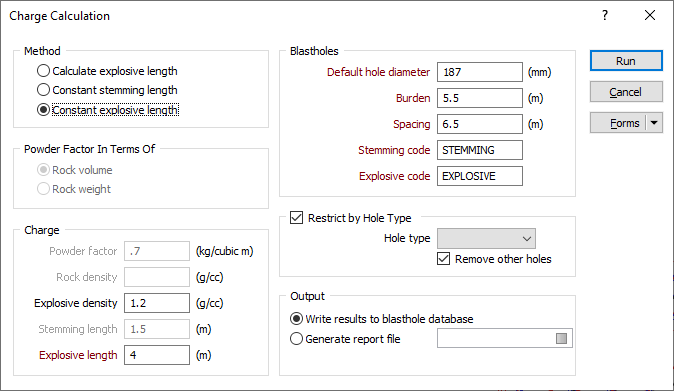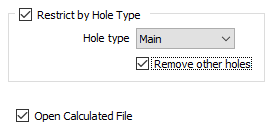Blast Charge Calculation
Select the Mining | Blasthole Design | Charge Calculation function to calculate the explosive lengths required for a series of blastholes. The purpose of this function is to calculate the length of explosive for each hole and then to write this information to an Interval file in the database.
If no Interval file is associated with the database, an Interval file will be created when you run the calculation.
To view how charges and volumes are calculated, see: How charges and volumes are calculated

Method
In the Charge Calculation form, select the method that will be used to calculate the explosive length or the stemming length and set charging parameters such as the Powder factor and Explosive density.
If you select Calculate explosive length, the function will calculate this value for each blasthole listed in the input file using the information you provide on the Input tab.
The other two options allow you to create an output file, provided that the charge or stemming length is constant and you know what the value is. The function can then calculate the charge or stemming length by subtracting the constant value from each hole depth.
You could also use this function to generate an interval file for samples.
Powder factor in terms of
If you have selected Calculate explosive length, you need to select one of these options.
- If you know how much explosive is required per cubic metre of rock, select Rock volume.
- If you know the ratio of weight of explosive to amount of material to be blasted, select Rock weight.
Charge
You must complete the mandatory Charge fields. The Powder factor must be specified as kilograms per cubic metre.
If you have chosen to Calculate explosive length, Explosive density is a mandatory input and must be specified as grams per cubic centimetre (gm/cc).
If you have selected the Constant stemming length or the Constant explosive length option, Explosive density is an optional input. The specification of an Explosive density value ensures that Explosive Weight values are written to the Interval file. These are needed in order to report on the consumption of the explosives.
If you have selected Calculate explosive length and Rock weight, you need to complete the Rock density field. This value represents the density of the rock, that is, the density ratio relative to pure water. As in the case of explosive density, this value must be specified as grams per cubic centimetre.
The Stemming length and Explosive length must be specified in metres.
Blastholes
Default hole diameter
Optionally enter a Default diameter (in millimetres). The function will extract the values from the Hole Diameter field that was specified as a parameter of the blasthole pattern. The default diameter you enter here will be assigned whenever a diameter value is missing.
Burden
This field is mandatory. Enter the amount of rock an explosive charge needs to move, in metres.
Spacing
This field is mandatory. Enter the space between blast holes, in metres.
Stemming code
Enter the value to be written to the Code field for stemming intervals.
Explosive code
Enter the value to be written to the Code field for powder column intervals.
Restrict by hole type
Select this option to restrict the charging calculation to holes of a specific type.

Remove other holes
When the Restrict by hole type option is selected, select this check box to clear calculations for other holes in the calculated file.
Hole Type
Double-click to select the Hole Type. Holes may be blasted for different purposes. You may want to differentiate between main, pre-splitiing, and auxilliary holes, for example.
Output
Generate report file
Select this option to write the results of the calculation to a (.RPT) Report file (the Interval file remains unchanged).
Write results to blasthole database
Select this option to write the results to the interval file associated with the blasthole database.
Run
Click Run to run the calculation. If you have chosen to generate a report file, the report is opened in the Report Viewer.